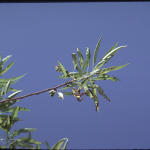Having a major role in many plant processes, potassium promotes root growth, increases kernel/fruit size, and provides key metabolic features that include the formation of starch, translocation of sugars, stomata regulation, and the formation of xylem vessels. In general, plants deficient in potassium tend to have slow growth, with small, pale leaves. Trees that are severely deficient may have necrotic tips and margins. In many cases, the leaf tip curls upwards in a common symptom that is named the “Vikings Prow” (Figure 1).

Since Potassium plays a large role in tree health, it is important to maintain proper levels of the nutrient within the tree. A critical leaf value of 1.4% has been established by the University of California and current research has suggested that levels above this value do not increase yields. Recent field studies by Roger Duncan (UCCE Stanislaus) have demonstrated that leaf potassium levels in excess of the 1.4-1.6% range did not increase yield. Through the study, leaf levels between 1.4-1.6% gave the best yield results, with yield decreasing when potassium levels were below this level. Leaf potassium levels higher than this range did not increase yield, and may actually reduce yields if applied in excess.
Potassium usage by the almond crop is high. Upon harvesting the hulls and kernals, potassium is removed from the orchard. Studies by Dr. Patrick Brown (UC Davis), have shown that 76 pounds of potassium (92 lbs of K2O) are removed from the orchard for every 1000 pounds of kernals harvested. From nutrient analysis of the fruit parts, 70-80% of the potassium removed by the harvest is within the hull, while the rest is within the shell and kernel.
Even though a large amount of potassium is used by the almond crop, it doesn’t always mean that large applications of potassium are needed to maintain critical levels. Some soils may have naturally high levels of potassium, depending on the parent material, percent of parent material degradation, soil texture, and the irrigation system. A soil analysis should be made to determine the amount of potassium within the soil and coupled with leaf tissue analysis to see if the potassium within the soil is available to the trees.
Once the potassium level within the soil drops, it will take several years of large applications to bring the levels back to normal. Potassium fertilizer products including sulfate of potash, muriate of potash, potassium nitrate, potassium thiosulfate, and a few others. Organic applications of potassium can be made through manure composts, green manures, guano, and wood ash. It is important to note that some potassium fertilizers may have unwanted chemicals/traits – chloride, sodium, alkalinity, and food safety concerns – which may have a negative impact on the orchard when applied in excess. Applications should be made to maintain the leaf critical level of 1.4%.
With the recent increases in costs of potassium fertilizers, it is important to keep in mind the potential damage caused by potassium deficiency. Inadequate levels will decrease the number of fruiting spurs on the tree, reduce the flowering of the surviving spurs, and reduce shoot and spur growth. In other words, deficient trees will yield poorly. Keep in mind that by the time symptoms of potassium deficiency are visible, yield has already been lost. Therefore, annual leaf samples and proper applications of potassium are recommended to maintain tree health and yield.


jjgross
October 8, 2010Does the 50lbs K per 1,000lbs of meats include the K removed with the hulls?
The Almond Doctor
October 8, 2010Yes, the nutrient removal analysis included hulls, shells, and kernels in determining the amount of potassium removed from the orchard. That is a good question considering that hulls contain a large amount of potassium – around 3% of their weight!
zellis
February 21, 2012Where does foliar supplementation of Potassium fit into a potassium program? Only if there is a deficiency in the tissue sample? Or can supplementation help during nut filling?
The Almond Doctor
February 22, 2012@ Zellis: Foliar sprays are very effective in overcoming deficiencies and providing micro-nutrients. It is clear that nutrients are picked up through the leaves. The debate on the exact role within a fertilization program is ongoing, and the the benefit of using multiple applications within the season has never been tested in UC studies.
In conversations with Patrick Brown (UC Davis), he does not seem convinced that the total amount of potassium needed (roughly 60lbs/1000 kernel lbs harvested) can be applied through foliar sprays.This does not rule out the use of these sprays as a tool to provide some of the trees needs of potassium, but complete reliance on foliar sprays to meet macronutrient needs does not seem feasible.
Some foliar spray studies applied at specific times have been completed. Three advisors (Duncan, Edstrom, Holtz) have completed foliar spray studies (micro- and macronutrient) at bloom and were not able to find any benefit/yield bump with applications at this time.
Major Nutrient Fertilizers: Thoughts to Reduce Operational Costs without Impacting Productivity - The Almond Doctor
October 30, 2021[…] Almond trees are also a major potassium (K) user. This material is applied as either a granular application in the fall and winter, or as liquids in-season. Due to the importance of K for spur viability, adequate levels of K should be applied to keep mid-July leaf levels at 1.5%. Having values higher than 1.5% has not been shown to increase yields. In cases of high leaf levels, soil samples should be conducted to determine how much K is available and corresponding rates can be reduced. Soil levels above 150 ppm exchangeable K are sufficient, and levels above this can be subtracted from fertilizer applications using the same formula as above. More information on K management can be found here and here. […]